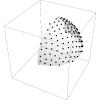当前位置:
X-MOL 学术
›
Phys. Rev. E
›
论文详情
Our official English website, www.x-mol.net, welcomes your feedback! (Note: you will need to create a separate account there.)
Chiral motion in colloidal electrophoresis.
Physical Review E ( IF 2.4 ) Pub Date : 2020-06-23 , DOI: 10.1103/physreve.101.062608 Lara Braverman 1 , Aaron Mowitz 1 , Thomas A Witten 1
Physical Review E ( IF 2.4 ) Pub Date : 2020-06-23 , DOI: 10.1103/physreve.101.062608 Lara Braverman 1 , Aaron Mowitz 1 , Thomas A Witten 1
Affiliation

|
Asymmetrically charged, nonspherical colloidal particles in general perform complex rotations and oblique motions under an electric field. The interplay of electrostatic and hydrodynamic forces complicates the prediction of these motions. We demonstrate a method of calculating the body tensors that dictate translational and rotational velocity vectors arising from an external electric field. We treat insulating rigid bodies in the linear-response regime, with indefinitely small electrostatic screening length. The method represents the body as an assembly of point sources of both hydrodynamic drag and surface electric field. We demonstrate agreement with predicted electrophoretic mobility to within a few percent for several shapes with uniform and nonuniform charges. We show that even symmetric shapes can have strong chiral twisting motions. The method applies more generally to active colloidal swimmers.
中文翻译:

胶体电泳中的手性运动。
不对称带电的非球形胶体粒子通常在电场下执行复杂的旋转和倾斜运动。静电力和流体动力的相互作用使这些运动的预测变得复杂。我们演示了一种计算人体张量的方法,该张量决定了由外部电场引起的平移和旋转速度矢量。我们以线性响应方式处理绝缘刚体,并具有无限小的静电屏蔽长度。该方法将车身表示为流体动力阻力和表面电场的点源的组合。我们证明了对于带均匀和不均匀电荷的几种形状的预测电泳迁移率在百分之几以内的一致性。我们证明,即使对称形状也可以具有很强的手性扭曲运动。
更新日期:2020-06-23
中文翻译:

胶体电泳中的手性运动。
不对称带电的非球形胶体粒子通常在电场下执行复杂的旋转和倾斜运动。静电力和流体动力的相互作用使这些运动的预测变得复杂。我们演示了一种计算人体张量的方法,该张量决定了由外部电场引起的平移和旋转速度矢量。我们以线性响应方式处理绝缘刚体,并具有无限小的静电屏蔽长度。该方法将车身表示为流体动力阻力和表面电场的点源的组合。我们证明了对于带均匀和不均匀电荷的几种形状的预测电泳迁移率在百分之几以内的一致性。我们证明,即使对称形状也可以具有很强的手性扭曲运动。



























 京公网安备 11010802027423号
京公网安备 11010802027423号